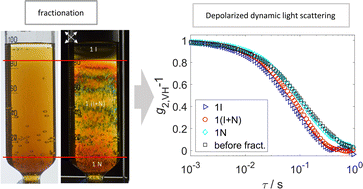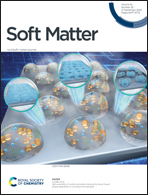Dynamic light scattering analysis of size-selected graphene oxide 2D colloids fractioned via liquid crystal phase separation†
Abstract
Exfoliated platelets of graphene oxide (GO) can be considered as polydisperse 2D colloids that form nematic colloidal liquid crystal phases in aqueous suspension even at very low concentrations thanks to their extremely high aspect ratios. However, with the rapidly emerging scientific interest in these GO-based liquid crystals, it became clear that the precise analysis and control of the GO sheet size distribution is essential, both for their scientific understanding and for potential applications, e.g., in optoelectronic devices, nanocomposites, or catalysis. In this work, we show that the mean effective (hydrodynamic) GO platelet width can be determined from the translational diffusion coefficient with depolarized dynamic light scattering by using a model for circular, infinitely thin disks. We further studied the phase separation process of biphasic isotropic–nematic GO dispersions and developed a simple fractionation protocol, which can be used to prepare relatively monodisperse fractions of GO sheets with widths ranging from 2.0–12.4 μm. Overall, we expect that the combined application of these relatively simple fractionation and analysis methods will advance the fabrication of well-defined and size-selected GO-based systems.



 Please wait while we load your content...
Please wait while we load your content...